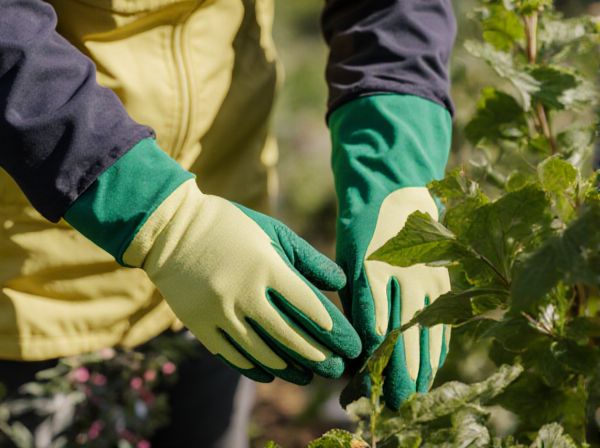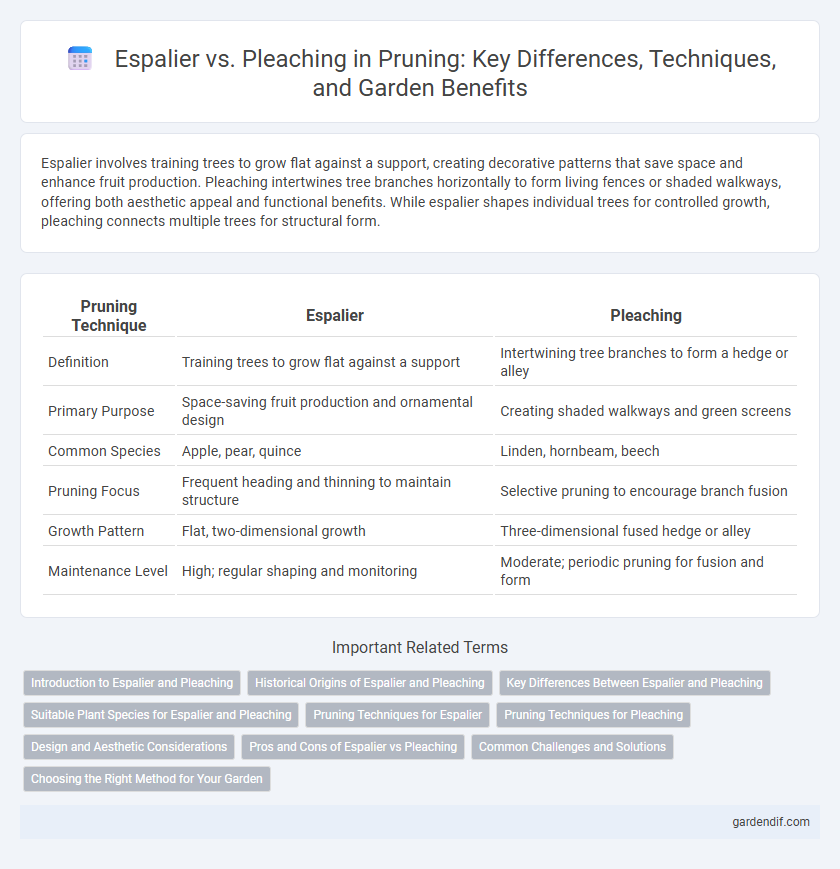
Espalier vs Pleaching Illustration
Espalier involves training trees to grow flat against a support, creating decorative patterns that save space and enhance fruit production. Pleaching intertwines tree branches horizontally to form living fences or shaded walkways, offering both aesthetic appeal and functional benefits. While espalier shapes individual trees for controlled growth, pleaching connects multiple trees for structural form.
Table of Comparison
| Pruning Technique | Espalier | Pleaching |
|---|---|---|
| Definition | Training trees to grow flat against a support | Intertwining tree branches to form a hedge or alley |
| Primary Purpose | Space-saving fruit production and ornamental design | Creating shaded walkways and green screens |
| Common Species | Apple, pear, quince | Linden, hornbeam, beech |
| Pruning Focus | Frequent heading and thinning to maintain structure | Selective pruning to encourage branch fusion |
| Growth Pattern | Flat, two-dimensional growth | Three-dimensional fused hedge or alley |
| Maintenance Level | High; regular shaping and monitoring | Moderate; periodic pruning for fusion and form |
Introduction to Espalier and Pleaching
Espalier is a pruning technique that trains trees or shrubs to grow flat against a support structure, maximizing space and improving fruit production by increasing sunlight exposure and air circulation. Pleaching involves interlacing tree branches, often of the same species, to create a living fence or raised hedge that provides both aesthetic appeal and functional screening. Both methods utilize careful pruning to shape plants, but espalier emphasizes flat, two-dimensional growth while pleaching focuses on intertwining branches in three dimensions.
Historical Origins of Espalier and Pleaching
Espalier originated in ancient Roman horticulture, where trees were trained against walls to maximize sunlight and space efficiency, a technique refined throughout the Renaissance in European gardens for fruit production and decorative purposes. Pleaching dates back to medieval Europe, primarily used in creating living fences and shaded walkways by intertwining tree branches, often in beech or hornbeam species, to form raised hedges for practical and ornamental functions. Both methods reflect historical techniques that shaped modern espalier and pleaching practices, emphasizing structural training of trees for aesthetic and agricultural benefits.
Key Differences Between Espalier and Pleaching
Espalier involves training individual tree branches flat against a support in defined patterns, optimizing space and fruit production on walls or fences. Pleaching creates a living hedge by weaving and interlacing tree branches horizontally, forming a raised, dense canopy ideal for privacy and windbreaks. Key differences include espalier's focus on decorative fruit tree shaping versus pleaching's emphasis on forming continuous, elevated green screens.
Suitable Plant Species for Espalier and Pleaching
Espalier is most suitable for fruit trees such as apple, pear, and fig due to their flexible branches and ability to produce abundant fruit along trained limbs. Pleaching commonly utilizes species like hornbeam, beech, and lime, which have dense foliage and strong growth patterns ideal for creating raised hedges and interlaced canopies. Selecting the appropriate species ensures optimal structural integrity and aesthetic appeal for each pruning technique.
Pruning Techniques for Espalier
Espalier pruning techniques involve training branches to grow flat against a support, such as a trellis or wall, using precise cuts to encourage horizontal growth and fruit production. Regular pruning focuses on removing inward or crossing branches, thinning dense areas to improve air circulation and light penetration. Skilled pruning promotes an open structure that enhances fruit size, quality, and easier harvest compared to other training methods like pleaching.
Pruning Techniques for Pleaching
Pruning techniques for pleaching involve selective cutting of lateral branches to create a flat, dense hedge-like structure on trees, promoting uniform canopy growth and enhanced shade. Regular maintenance pruning encourages the intertwining of branches, forming a stable framework essential for the pleached effect. Compared to espalier, which focuses on training branches flat against a support, pleaching requires precise trimming to maintain height and width, ensuring consistent light penetration and air circulation.
Design and Aesthetic Considerations
Espalier involves training trees flat against a support, creating precise geometric patterns ideal for formal gardens and maximizing space efficiency. Pleaching interweaves tree branches to form elevated green walls or corridors, offering a more three-dimensional, sculptural effect that enhances garden pathways. Both techniques emphasize structural aesthetics, but espalier favors symmetry and order, while pleaching provides organic texture and dynamic shading.
Pros and Cons of Espalier vs Pleaching
Espalier maximizes space by training plants flat against a structure, improving air circulation and sunlight exposure, which enhances fruit production and reduces disease risk. Pleaching creates a raised hedge through interwoven branches, providing a living fence and aesthetic appeal but requires more maintenance and skillful pruning to maintain the structure. While espalier suits small gardens with limited space, pleaching is ideal for formal garden designs needing privacy and windbreaks.
Common Challenges and Solutions
Espalier and pleaching both face challenges such as managing plant stress and ensuring structural support during growth. Common issues include pest infestations and fungal diseases, which require regular monitoring and timely pruning to maintain plant health. Effective solutions involve using disease-resistant cultivars, applying targeted treatments, and implementing proper training techniques to balance foliage density and airflow.
Choosing the Right Method for Your Garden
Espalier suits small gardens where space-saving and decorative wall training of fruit trees is desired, providing a formal and artistic structure. Pleaching favors larger garden avenues or borders, creating living fences by weaving tree branches horizontally for shade and privacy. Selecting the right method depends on garden size, aesthetic goals, and desired functional outcomes such as fruit production versus structural hedging.
Espalier vs Pleaching Infographic

 gardendif.com
gardendif.com